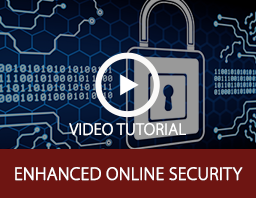We work in partnership with you to keep your accounts and information secure. Here are some recommendations for what you can do to protect yourself.


Use the strongest method available to log into financial accounts - Use the strongest authentication offered, especially for high-risk transactions. Use passwords that are difficult to guess and keep them secret. Create "strong" user IDs and passwords for your computers, mobile devices, and online accounts by using combinations of upper- and lower-case letters, numbers, and symbols that are hard to guess and then change them regularly. Although using the same password or PIN for several accounts can be tempting, doing so means a criminal who obtains one password or PIN can log in to other accounts.
Understand Internet safety features - You can have greater confidence that a website is authentic and that it encrypts (scrambles) your information during transmission if the web address starts with "https://." Also, ensure that you are logged out of financial accounts when you complete your transactions or walk away from the computer. To learn more about additional safety steps, review your web browser's user instructions.
Be suspicious of unsolicited e-mails asking you to click on a link, download an attachment, or provide account information - It's easy for cyber criminals to copy the logo of a reputable company or organization into a phishing email. When responding to a simple request, you may be installing malware. Your safest strategy is to ignore unsolicited requests, no matter how legitimate or enticing they appear.
Be careful where and how you connect to the internet - Only access the Internet for banking or for other activities that involve personal information using your own laptop or mobile device through a known, trusted, and secure connection. A public computer, such as at a hotel business center or public library, and free Wi-Fi networks are not necessarily secure. It can be relatively easy for cyber criminals to intercept the Internet traffic in these locations.
Monitor your credit report - According to the Federal Trade Commission, there is only one authorized source for free credit reports, and that’s AnnualCreditReport.com. You can reach them via their website or by calling 1-877-322-8228.
File your taxes early - Filing your tax return as early as possible can help prevent identity theft. This way, you can make sure your legitimate filing gets in before any thief has the chance to submit a fraudulent one. According to the IRS, frauds typically send in fake tax filings early in the year to get a taxpayers’ refund before they have the chance to. That’s why the IRS suggests filing earlier, as it lessens your chance of being victimized.
Shred all documents - With all the digital resources out there, it sounds so outdated, but identity thieves still rifle through trash cans to retrieve documents containing sensitive personal information, giving them the access to compromise your identity. To prevent this, you should resolve to shred all documents containing any information you wouldn’t want in the hands of a thief, like all those receipts you have from your holiday shopping. You can start your shredding process by going through all old mail, bank account statements and bills. Consider investing in a cross-cut shredder, which ensures that a shredded document can never be put back together.
Be careful when using social networking sites - Cyber criminals use social networking sites to gather details about individuals, such as their place or date of birth, a pet's name, their mother's maiden name, and other information that can help them figure out passwords - or how to reset them. Don't share your "page" or access to your information with anyone you don't know and trust. Cyber criminals may pretend to be your "friend" to convince you to send money or divulge personal information.
Take precautions with your tablet or smartphone - Consider opting for automatic updates for your device's operating system and "apps" (applications) when they become available to help reduce your vulnerability to software problems. Never leave your mobile device unattended or use a password or other security feature to restrict access in case your device is lost or stolen. Make sure you enable the "time-out" or "auto-lock" feature that secures your mobile device when it is left unused for a certain period of time. Research any app before downloading it. Consult your financial institution's website to confirm where to download its official mobile application.